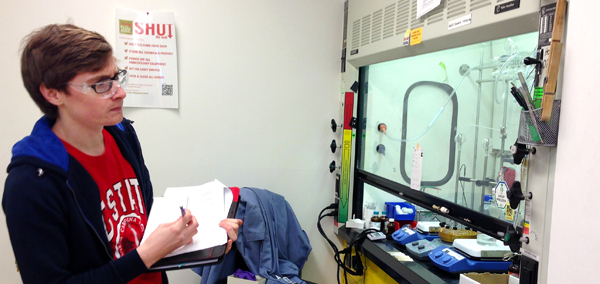Student leads effort to save energy, improve safety in campus labs

Every Friday afternoon this semester NC State senior Caleb Melvin has walked the halls of some of the most research-intensive buildings on campus looking for opportunities to improve safety and energy savings.
As many buildings are being vacated for the weekend, Caleb, an intern with Energy Management and Environmental Health and Safety combs through labs looking for open fume hoods, which are among the university’s single biggest source of energy loss each year.
By providing a physical barrier between researchers and hazards, a fume hood keeps students and researchers safe from hazardous material that could result from experiments. Energy loss occurs when after the experiment a user doesn’t close the fume hood’s glass barrier, called a sash, allowing indoor air to be constantly circulated out of the lab and pushed out of the building. This energy loss costs the university up to $6,000 annually per fume hood.
“Some of the labs [I go in] appear to be unused so when those fume hoods are closed, that’s a lot of energy savings,” said Caleb, whose internship is part of an external learning experience to complete his Environmental Science degree.
When he finds an open fume hood that’s not in use, he leaves a card reminding the lab user of the importance of shutting the sash. He also monitors fume hoods in use looking for any sash that’s open above 18 inches, which is beyond the recommended safety and energy saving levels.
These days he’s saying, “Awesome, thank you,” to more and more lab users as the message about shutting the sash for energy and safety appears to be gaining traction in some buildings.
“At the beginning I found probably 3 in every 10 fume hoods open, and now it’s a lot less,” Caleb said. “There used to be many open above 18 inches but now they’re at 6” or lower so that’s also much better.”
Caleb’s Friday lab walkthroughs are also an opportunity to shut off lights in unoccupied rooms and to identify consistently unused fume foods that could be closed temporarily for greater energy savings. He also does fume hood testing to ensure that fume hood air velocity is optimal. If it’s too high, too much energy is wasted, and if it’s too low, the hood isn’t providing enough safety protection for lab users.
“I love NC State and being able to make a difference on campus like this is great,” he said.